#Protein primary structure
Explore tagged Tumblr posts
Text
Wet Beast Wednesday: bone-eating worm
Happy (almost) Halloween from us at Wet Beast Wednesday. What better to celebrate the spooky holiday than with a spooky animal? These critters are so spooky they even scare skeletons. Sometimes called zombie worms or bone worms, bone-eating worms are scavengers that play an important role in deep seas. Try not to get too scared.
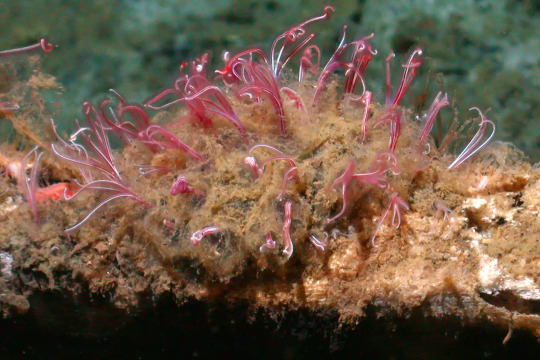
(Image: a cluster of bone-eating worms on a bone. Their plumes are visible, looking like red feathery structures emerging from a clump of brown sludge. End ID)
Bone-eating worms are members of the genus Osedax, with 26 species currently known. My favorite is Osedax mucofloris, which means "bone-eating snot flower". They are small tube worms, reaching between 2.5 and 7 cm (1 to 2.7 in) in length. The body is divided into three segments, the trunk, ovisac, and root. The trunk makes up the majority of the body and it topped by red plumes that act as gills. At the base of the trunk is the ovisac, where eggs are produced. Below that are the roots that bore through the bones the worms live on. This is done by secreting carbonic acid that is produced through anaerobic respiration. The roots also produce a mucus sheath whose purpose is not fully known. It may protect the body from the acid or may prevent the acid from dissolving the hole the worm lives in. As with other tubeworms, the worm generated a protective sheathe to live in. Normally, the plumes extend out of the sheathe to respirate, but when threatened, they will withdraw into the tube.
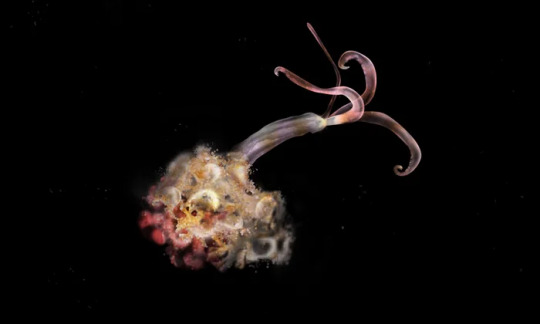
(Image: a bone worm removed from the bone. It is a long, translucent tube with reddish plumes on one and a lump of wavy roots on the other. End ID)
Bone-eating worms lack a mouth, anus, and digestive system. To obtain nutrients, they exist in a symbiotic relationship with bacteria. As the worms break down the bone, they release lipids and proteins that the bacteria consume to produce energy in the form of glycogen, which is transferred to the worm. The worm then uses the glycogen to power itself and feeds it to the bacteria to keep them alive. The worms also use collagen, which is the primary component of bone. Many of the symbiotic bacteria species need the collagen, which the worm provides by breaking down the bone. Curiously, many of the symbionts produce toxins that disrupt the membranes at the roots, leading to infection. The bacteria are also found surviving outside of symbiosis with the worms Because of this, it is debatable whether the relationship between the worm and its bacteria is mutualistic (both parties benefit) or commensal (one party benefits, the other neither benefits nor suffers).
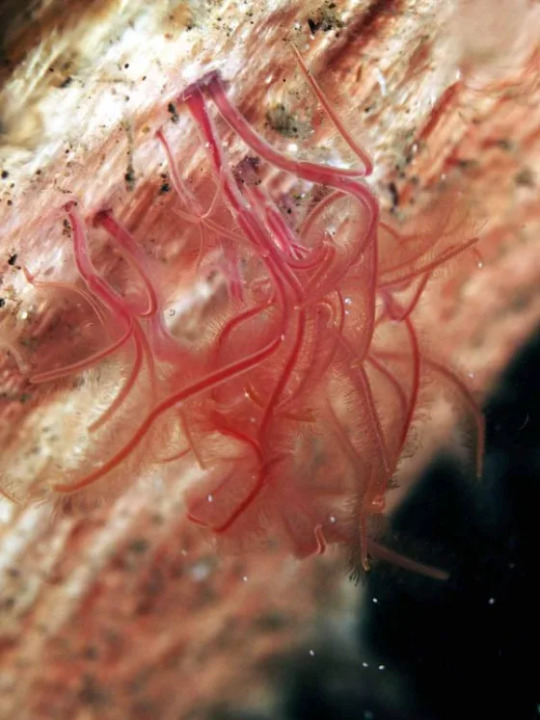
(Image: a cleared view of bone worm plumes emerging from a bone. End ID)
Bone-eating worms are found worldwide in oceanic depths ranging from 10 to 4,200 meters (30 to 14,000 ft). They are most commonly found on the skeletons of whales, but will also colonize fish bones and even, in one experiment, cow bones. Whale bones seem to be preferred both because of their large size and the large quantity of lipids found within. Whale skeletons can often be seen covered with bone worms, giving them the appearance of red shag carpeting. As the worms break down bones, other animals can take better advantage of the nutrients within. The presence of bone worms at a whale fall has been shown to increase the biodiversity of the site. Bone-eating worms are ecosystem engineers, organisms that significantly alter their habitat. They have been doing this since before whales existed. Fossil sea turtle and plesiosaur bones have been found with signs of bone worm colonization.

(Image: a lone bone worm with its tube visible. Its plumes are whitish. End ID)
The bone-eating worms have one of the most dramatic cases of sexual dimorphism in the animal kingdom. All the worms you see when you look at a whale skeleton are females. The males are 20,000 times smaller and fully microscopic. They still resemble larvae, making them a case of neoteny, an adaptation where juvenile characteristics are retained into adulthood. Harems of males live inside the females' tubes and feed on the nutrients released by the bacteria. As the female generates eggs, the males fertilize them. The eggs hatch inside the female's tube and stay for a while to mature before being released into the water. The fact that the worms are so widely distributed indicated that the larvae can travel vast distances to find a new set of bones, but the means they use to do so is unclear. The extreme sexual dimorphism reduces competition between males and females and ensures the males will always have an available mate to pass on their genes. The species Osedax pirapus do not follow this form of dimorphism. Males are still smaller than females, but they actually look like worms and share the same lifestyle. This increases competition between males and females, but ensures that males can make far more sperm due to their greater size.
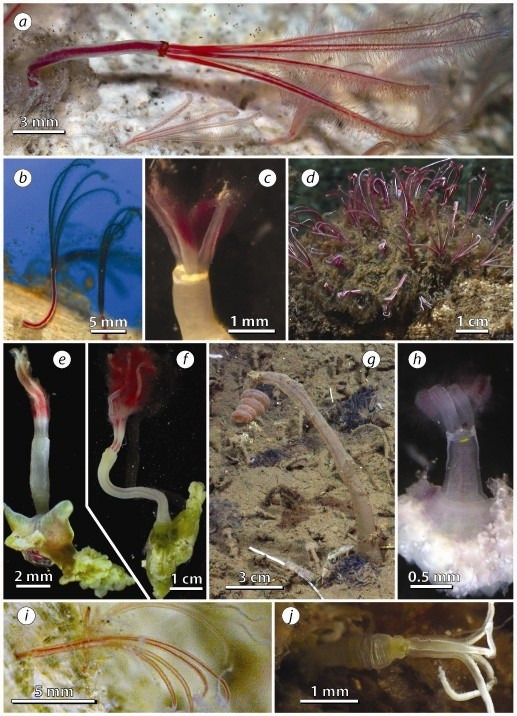
(Image: a collection of images of multiple species of bone-eating worms. Source. End ID)
#BONES FOR THE BONE WORM#wet beast wednesday#bone eating worm#bone worm#zombie worm#osedax#worm#tube worm#polychaete#wormblr#halloween#whale fall#invertebrates#invertiblr#marine biology#marine life#biology#ecology#zoology#animal facts#informative#educational#image described
233 notes
·
View notes
Note
I love this idea.
Can you render the lyrics of Never Gonna Give You Up?
i’ve gotten this request several times now, so for anyone who asked for this after uniquepickles you can just look at this post.
enjoy!:
letter sequence in this ask matching protein-coding amino acids:
WerenstrangerstlveYknwtherlesandsdIdIAfllcmmitmentswhatImthinkingfYwldntgetthisfrmanythergyIstwannatellyhwImfeelingGttamakeynderstandNevergnnagiveypNevergnnaletydwnNevergnnarnarndanddesertyNevergnnamakeycryNevergnnasaygdyeNevergnnatellalieandhrtyWeveknwneachtherfrslngYrheartseenachingtyretshytsayitsayitInsidewethknwwhatseengingngingnWeknwthegameandweregnnaplayitAndifyaskmehwImfeelingDnttellmeyretlindtseeNevergnnagiveypNevergnnaletydwnNevergnnarnarndanddesertyNevergnnamakeycryNevergnnasaygdyeNevergnnatellalieandhrtyNevergnnagiveypNevergnnaletydwnNevergnnarnarndanddesertyNevergnnamakeycryNevergnnasaygdyeNevergnnatellalieandhrtyWeveknwneachtherfrslngYrheartseenachingtyretshytsayitsayitInsidewethknwwhatseengingngingnWeknwthegameandweregnnaplayitIstwannatellyhwImfeelingGttamakeynderstandNevergnnagiveypNevergnnaletydwnNevergnnarnarndanddesertyNevergnnamakeycryNevergnnasaygdyeNevergnnatellalieandhrtyNevergnnagiveypNevergnnaletydwnNevergnnarnarndanddesertyNevergnnamakeycryNevergnnasaygdyeNevergnnatellalieandhrtyNevergnnagiveypNevergnnaletydwnNevergnnarnarndanddesertyNevergnnamakeycryNevergnnasaygdyeNevergnnatellalieandhrty
protein guy analysis:
i was really interested to see how this one would turn out, as it is made up almost entirely of repeated domains (the chorus). unfortunately, as many of you may be quick to point out, the chorus of Rick Astley's 'Never Gonna Give You Up' is not in fact a protein domain, and the only thing repeated are some terrible looking loops. i've even included a second picture to properly show you how flat this terrible protein is.
i thought i understood Levinthal's paradox before starting this blog, but these structures are giving me a newfound appreciation. for those who are unaware, Levinthal's paradox is based on the fact that any given protein can fold into an enormous number of possible conformations, but cannot test all of these within the seconds or less that it takes for a protein to fold into its stable tertiary structure. correct folding is controlled by the primary structure (or, the sequence of amino acids encoding the protein) as well as complex factors including the presence of any chaperones to assist with folding, and the relative abundance of the tRNAs matching specific codons for each amino acid. running this blog makes me think of all the ways this process can fail along the way, and all of the almost correct places a protein can get stuck. this one certainly looks like it failed, but even then its hard to believe this is the shape that stuck.
for those interested, the one beta sheet goes with the line 'you wouldn't get this from any other guy', which does only occur once in the song.
predicted protein structure:

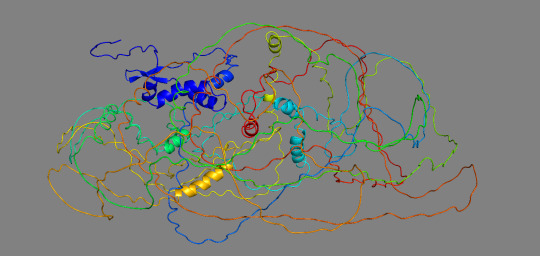

#science#biochemistry#biology#chemistry#proteins#protein structure#science side of tumblr#protein asks#rickroll#never gonna give you up#protein memes#protein songs
181 notes
·
View notes
Text
Current Sevastiel Lore Theories List
(Misc collection of all my interpretations/theories on lore thus far. Warning, theres a LOT. Primary focus on void functions and infestation functions.)
==
Techrot feed off of energy moreso than they do metal, metal is mostly a conductor and a material that can be used to create more resilient and complex structures. This is why they Can consume machines. (Partially proven correct)
The infestation uses a powerful base to dissolve through things, not an acid. Allows less ultimately destructive techniques and minimum energy loss. Also makes scaldra's use of specifically acid more understandable.
The infestation do not necessarily require a protein base to create their bio... stuff. This is why they can infest, say, a planet, and somehow have the biomass to cover the entire surface without an entire surface covering's worth of protein based life forms. What they do use is absolutely beyond me. Current guess is probably silicon for structure base, as carbon is organic.
Everyone has a bit of void energy inside of them that is modified by their experience. That is what a Soul is, and why people echo in the void after their death. (Consider the Kim discussion with eleanor about the void and the afterlife)
Void energy past a very small amount is very difficult to hold onto if you arent modified to be able to hold more of it, but if you are imbued with more than youre regularly able to hold onto, it can/will fuck up your soul. This is why people who interact with the void go insane, instead of just getting powers.
The adults on the zariman were given an understanding of both the nature of eternity and also what the tenno would become, and how much KILLING they would do. Also, that the tenno would be far more complete void vessels, which could, if they could consume them, possibly allow them to contain more power/and/or not be destroyed by the void
Tenno blood could be used as kuva. The physical aspect of the tenno is, at very least, VERY well equipped to hold onto void energy and thusly ingesting it might spread the effect. (No it wont lol) Queens wanted to transfer into a tenno because of the void capacity.
Red kuva primarily fucks with your mental aspect of the soul(allows the orokin transfer of consiousness) whereas blue kuva fucks with your physical aspect of the soul (allows shapeshifting, in lore) and thusly purple kuva could probably allow you to just Become Anyone
Everything is essentially the void. Reality is held together, much like duviri, by the expectation and understanding of everyone that exists within it. Common consensus decides that the sun keeps rising/that gravity continues to work.
The physical look of the tenno/drifter is entirely based on their perception of self. This is why we can change our cosmetics/gender/voice on a literal whim, and ultimately means that we are not really limited to human forms. Conceptual em-body-ment :)
Void tongue is not an actual language, per se. Each word is more or less simply describing a concept/idea that is taken from across externalism, which is why each word is described with a poem, and not a regular definition. Its like saying 'water' and truly meaning/referring to all of water, everything that has experienced it, every emotion that anyone has ever had about it, every moment that it has existed, and every interaction that it has had with every other thing. This is why void tongue drives you mad to understand it, because it just pushes your mind so far beyond its limits. Like an ant suddenly being raised to the awareness of a human with all the understanding we have of our world, the knowledge of taxes and society and the way people act, all while still limited by the few neurons of an ants brain. The soul can retain that information, your body/brain cannot, and the discrepancy is probably upsetting.
The mind is the connection point between the soul and the body, the void and the physical world we've made, and that is why it is capable of affecting the void at all.
Because our reality is held together by what we think it is, that order extends to all of it, even things that we inherently think of as chaotic, like our energy. Our energy is VERY orderly, and it tends to exert that order on things it comes in contact with. This is why the murmur and void enemies are weak to radiation and electrical damage, because its a high amount of ordered energy that comes up against energy that is only chaotic because nobodys gotten around to ordering it up yet.
Transference works through the manipulation of electrical systems across gaps translated through the void. Void energy to open up the link is necessary. This is why warframes are very Much Metal, and why transference bolts are metal. Because that shit is conductive. It allows us to literally mirror our brain signals inside of a warframe's brain, and visa versa. This is why transference is hard to fight off, and why a stronger will allows domination over the other. Orokin transference probably allows them to cheat at this by amplifying their signals a few times through manipulation of void energy.
Void portals need both a void energy component and an order energy component. The void energy to open the tear in reality, the order energy to pave a way through the void to another place. Like digging a tunnel in sand, and using wooden planks to line the walls to keep it from collapsing. This is why all the void portals we see/use often are tied to large energy generators, and why albrecht needed a nuclear reactor detonation to have enough power to time travel. You need a LOT of power to travel the void safely unless you're of the void, like a tenno is.
Archon shards are 'anti-entropic radiation', which is, I assume, the sentient's way of dealing with the void radiation that would end their race otherwise. The void is said to be both entropy and anti-entropy, it decays, it creates, yadda yadda, so if you order it to be specifically non-entropic through some process, you can basically lock it into one manageable form. Its still void energy, which is why they're not commonly used outside of warframes and archons, but its still a containment method. I wonder if Albrecht is at all curious about how the sentients in tau managed to find ways to contain void energy. Seems it could be useful to him.
Archon shards are not perfect, as we can see them visibly leaking void particle styled energy, and the 'effect' we get from an archon shard is due to a specific desire/idea that the crystalized energy is centered around being. Tauforged shards have more energy. if they are described as anti-entropic, we must assume taht means they are at least mostly so. So, most of the energy that escapes gets pulled back in, and we use the liiittle bit that we siphon off the top/that leaks out. Like drinking from a recycling water fountain but infinitely less gross.
Void energy tends to either pull in more void energy, or de-order the energy around it. Chaos begets chaos, entropy begets entropy.
The albrecht membrane is literally the separation between what is and what we think is.
The skin of a warframe is bolstered by multi-cell-wall layers, (The tougher/more leathery bits, maybe 2? the more flexible bits maybe just 1? unsure. Not a biologist, just talked with some.) growths akin to a horses hooves but with a more flexible structure, (the toughest bits) pleeenty of lignin, a thick layer of skin/padding overall, and an underlayer beneath the skin of a thick, non-Newtonian liquid. Likely either highly conductive or held within a lattice of highly conductive tissues, possibly incorporating metals like gold into the structure either held between cells or somehow within them. The outer layer offers us our slash resistance, the fluid provides both the impact resistance and the energy channels for our energy to go through, and is what makes up our emissive effects. Also is why all the orokin towers have that layer of golden veining beneath the fat and flesh, and are able to 1, bleed, and 2, transmit/control energy.
Warframes have extra organs/mechanisms for storing both bioelectricity and a pinch of void energy. Void energy draws in itself, but might struggle to do so when surrounded by regular energy, which keeps it contained and harmless. Most of the warframe's abilities are pulled from the void energy collective, physical functions are pulled from the bioelectricity collective. Shields are probably fueled from the bioelectricity, and abilities are from the void. (theres no physical way at all ever to generate enough energy to unleash a portal to the sun at whim) This is why we naturally have no/very low energy regen, and start missions at very little energy, because holding a high amount of void energy in general would be Extremely dangerous.
Energy orbs are kinda just The Power That Makes Up That Guys's Fucking Soul. Consume it to use void magic. Yippee.
Overguard is made up of void energy. (glances at kullervo) It allows the haver to simply Resist shit because with that much void energy around you, it can 1, nullify energy that comes into contact with it, (stop bullets by instantly countering out kinetic energy, absorb the impact of a fall, etc etc) and 2, it sort of just alters your percieved 'existence' when it comes to other void things. Like, a void ability will just blitz through or slide off, which is why we cant target overguarded enemies with abilities. Their physical location exists, but their physical energies do not.
Eximus units are probably people who have specialized units of programmed void energy that they can utilize. I dont imagine they last long power-wise or mentally.
Infested eximus units probably have the same separation between void energy organs and bio-electric organs as warframes do.
The infestations various hiveminds came to be because it consumed living beings with souls/connections to the void, and, as void energy risks destroying regular energy, and it NEEDS the regular energy to exists, it probably had to contain it carefully. that adds up, and all those souls together, all those memories, all that consciousness, would form the hivemind.
Wally/all of the clones are a decentralized hivemind. All have access to the same knowledge/shit, but each individual facet/clone creation is just that, its own facet on the same gem.
Thrax is the drifter's void clone, but is the natural one that happened not because the wally collective made it, but the result of the drifter really REALLY wanting someone to protect them/a friend, and only having themselves. A shadow cast with natural light, instead of a shadow cast by wally pointing a flashlight at someone.
Warframes feed through the helminth, which is why we dont need to feed them but do need to stuck up the wall mouth, and why their backs always look so rough.
The warframes we pilot are shadows of the originals, with the orokin having devised ways to sever parts of the brain to reduce the likelihood of them having consciousness while retaining their capacity for memory.
The mod system/arcanes are a mixture of a physical item, like a little chip, and a charge of stabilized void energy thats set to do a certain thing. Like an archon shard, but less... Archon-y. And way less powerful. Powering up the mod is done by increasing the charge of energy within the chip, which increases its effects on reality. Stick those mfers in the warframe's spine or something. The physical aspect of the modding system is why we cannot alter the protoframe's modding, because Ow.
Time travel works by anchors if you dont want to do it the regular way. Go into the void and pray you can keep your destination in mind. (Proven correct, thank fucking god)
you could kill a tenno with a sufficient amount of energy.
The ascaris probably worked on the same wavelength as transference. (metaphorically) And probably both induced brain-wave style electrical waves and charges of a high enough power, siphoned from the warframe's own energy supplies, to eat through the void energy.
#warframe#These are all entirely my lore interpretations#and I will likely update this list as time goes on.#For Later
38 notes
·
View notes
Text
Also preserved in our archive (Daily updates!)
Published Sept 3, 2024
By Chuck Dinerstein, MD, MBA
New research reveals that fibrin, a key component of blood clots, may be the secret culprit behind the devastating neurological and inflammatory aftermath of the virus, including long COVID. From dense, stubborn clots to brain fog, the interaction of COVID’s spike protein with fibrin could be the missing link — and a potential target for life-saving therapies.
Coagulopathy, the formation of small blood clots that go on to wreck respiratory and neurologic havoc, has long been a clinical hallmark of COVID, and now it's oft-ignored Long COVID. A new study suggests that fibrin, a key component of blood clots, plays a role.
Fibrin provides structure to a blood clot and is derived from fibrinogen, a soluble blood protein when the coagulation cascade is activated. If you think of a blood clot as nature’s way of plugging a leak, fibrin deposition is frequently found where there is damage to the walls of blood vessels and the vessels making up the blood-brain barrier. Fibrin serves as a plug and a signal for a greater inflammatory and immune response.
Given the unique clinical presentation of clotting in COVID compared to other respiratory viruses, the researchers hypothesized that COVID directly binds to fibrinogen, promoting blood clot formation and altering clot structure and function. They found that the spike protein of the virus binds to fibrinogen and fibrin at specific binding sites, suggesting that the virus might contribute to abnormal clotting by interacting with fibrinogen.
They found that the spike protein altered the structure of clots, making them denser and more resistant to the body’s natural means of removing clots, a process called fibrinolysis. Additionally, the spike protein enhanced the inflammatory signals from fibrin, increasing oxidative forces (reactive oxygen species or ROS) released from macrophages, a first responder of the immune system.
In converting fibrinogen to fibrin, the spike's binding site (epitope) is exposed. Therapeutically, having identified binding regions, the research found that antibodies could disrupt and reduce these pro-inflammatory effects implicated in acute and long COVID. Among the inflammatory effects reduced by blocking the actions of fibrinogen was the deposition of collagen in the lungs, which creates a barrier to oxygen passage and helps to explain the refractory response to supplemental oxygen we have seen in patients.
Fibrin also suppresses natural killer (NK) cells, which are called "natural killers" because they can recognize and kill stressed cells without prior exposure to a particular pathogen, making them critical first responders. The suppression of NK cell activity results in enhancing viral persistence and lung inflammation.
In additional studies in mice, the researchers found that this fibrin-dependent inflammatory response occurs independently of the active virus, suggesting a potential mechanism for persistent symptoms in Long COVID. [1] Therapeutically, in their mouse model, the use of a monoclonal antibody targeting the fibrin epitope, in addition to reducing the lung’s inflammatory response, reduced neuroinflammation (associated with long COVID’s brain fog). There were reductions in fibrin deposition and microglial reactivity “leading to improved neuronal survival and reduced white-matter injury.” Microglia are the primary immune cells of the central nervous system.
To summarize:
Coagulopathy in COVID-19 is a primary driver of thrombo-inflammation and neuropathology rather than a consequence of systemic inflammation. Fibrin plays a causal immunomodulatory role in promoting hyperinflammation, neuropathological alterations, and increased viral load in COVID-19 by modulating NK cells, macrophages, and microglia. Elevated fibrinogen levels and BBB permeability in COVID-19 contribute to neuropathology, and targeting fibrin may offer a dual mechanism of action by inhibiting fibrin-spike interactions and exerting anti-inflammatory effects. A fibrin-targeting antibody effectively blocks many pathological effects of fibrin, providing neuroprotection and reducing thrombo-inflammation. Their findings have limitations, including how they measured changes in brain tissue, the use of mouse models, and the fact that our inflammatory response may have more than one pathway that results in COVID-19’s deleterious effects. For Long COVID, the fibrin-targeted antibody does not interfere with normal clotting, acting solely on fibrin's inflammatory responses, making it a candidate to protect against pulmonary and cognitive impairment; that will, of course, require clinical trials.
And there you have it—the silent saboteur behind the lingering specter of Long COVID. Fibrin is not just a bystander in the aftermath of COVID-19; it's a key player driving the chronic symptoms that continue to baffle patients and clinicians alike. The discovery that the virus’s spike protein meddles with fibrin, transforming it into a resilient, inflammatory force, opens a new frontier in the fight against the pandemic’s long tail. The research, though groundbreaking, is still in its early days, confined to animal models, and the complexities of human biology could introduce new challenges.
But if the science holds, targeting fibrin could offer a two-for-one punch against the clotting and inflammation that underpin much of the damage COVID-19 leaves in its wake. For the millions grappling with the enduring effects of Long COVID, this could be a glimmer of hope—a chance to reclaim their lives.
[1] The inquisitive with a conspiratorial bent might link these inflammatory responses in the absence of infection to deaths felt to be due to the COVID vaccines, which employ the spike as antigenic stimulus. The researchers note that most hematologic changes are triggered by the vaccine vector (an adenovirus) and that “COVID-19 RNA vaccines lead to small amounts of spike protein accumulating locally and within draining lymph nodes where the immune response is initiated, and the protein is eliminated.”
Source: Fibrin drives thrombo-inflammation and neuropathology in COVID-19 Nature DOI: 10.1038/s41586-024-07873-4 www.nature.com/articles/s41586-024-07873-4
#mask up#wear a mask#public health#pandemic#covid#covid 19#wear a respirator#coronavirus#still coviding#sars cov 2#fibrin#long covid#brain fog#chronic illness
77 notes
·
View notes
Text
Ginseng's role in traditional medicine is underscored by its complex genetic structure due to its allotetraploid nature. A recent study delves into this complexity, revealing key evolutionary insights into its subgenomes that govern saponin biosynthesis—the primary active compounds in ginseng. This necessitates deeper genetic research to fully harness ginseng's medicinal potential. Led by Nanjing Agricultural University, the study was published in the April 2024 edition of Horticulture Research. Researchers meticulously constructed a complete 3.45 Gb genome of Panax ginseng, identifying 77,266 protein-coding genes and focusing on the pathways and biosynthesis of ginsenosides—crucial for the plant's medicinal properties. This work significantly enhances the understanding of ginseng's biological complexities and its therapeutic potentials.
Continue Reading.
80 notes
·
View notes
Text
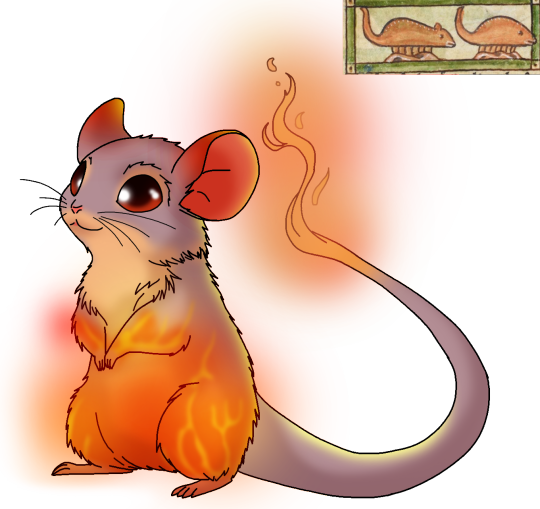
Creature Name
Common Name: Cindermice
Scientific Name: Ignisomys calidus
Physical Description
Average Size:
Body length: 15–20 cm (6–8 inches)
Tail length: 20–25 cm (8–10 inches)
Appearance:
Small, round-bodied rodent with thick, soft fur resembling embers.
Fur shifts in color from smoky gray near the head to glowing orange along the belly and limbs.
Large, expressive eyes with a slight red sheen, adapted for low light.
A long, smooth tail that emits gentle warmth and faint wisps of heat when excited or threatened.
Unique Trait: Its body radiates warmth, making it a living heat source.
Diet
Type: Omnivore
Primary Foods:
Nuts and seeds rich in oils to fuel its internal heat.
Root vegetables and dried grasses.
Small insects for additional protein.
Special Adaptations:
Has a specialized metabolism that converts food into heat energy.
Stores excess warmth in its fur and tail, which slowly dissipates over time.
Habitat
Environment: Cold climates, such as snowy forests, tundras, and mountainous regions.
Shelter: Nests in burrows, tree hollows, or even inside human dwellings where it provides warmth in exchange for food.
Behavior and Living Habits
Activity Cycle: Crepuscular (most active at dawn and dusk).
Social Structure:
Lives in small family groups, often huddling together for shared warmth.
Forms bonds with humans and is sometimes kept as a companion animal.
Territoriality: Non-aggressive, prefers to flee rather than fight.
Reproduction
Mating Season: Late autumn to early winter.
Reproductive Strategy:
Gestation lasts approximately 5 weeks.
Litters typically contain 3–5 pups.
Young are born blind and furless but develop their signature ember-like glow within two weeks.
Nest: Insulated burrows lined with soft, dry vegetation to retain warmth.
Behavior and Temperament
Defensive Behavior:
When threatened, its tail flares with heat, deterring predators.
Can release a brief pulse of warmth to startle attackers.
Foraging Habits: Stores food in underground caches for winter months.
Interaction with Humans:
Often kept as pets by those in cold regions.
Friendly, docile, and enjoys curling up with warm-blooded creatures for shared heat.
Used in folklore as a symbol of home and hearth.
#art#original story#original character#fairytale#creature#creature design#bestiary#monsters#creature art#mouse#cindermice#mice#fantasy creature#monster design#fantasy character#Legends of the Written Realms#LoWR#fablewood academy
27 notes
·
View notes
Text

Transmechanicus Xenologis Field Report
Study Log Entry: 961.M41
Subject: Planetary Survey of Nullius-57, Orkoid designation “Og”
By: Magos Xenologis Xanthor Vell (Excommunicated)
Location: Segmentum Obscurus, Uncharted Subsector
I. PLANETARY CLASSIFICATION
Imperial Registry: Nullius-57 (Unofficial)
Orkoid Designation: Og — interpreted as “Owned by / Property of” in local feral Ork dialect
Segmentum: Obscurus
Planetary Type: Oceanic-Terranic hybrid
Size: Approximately 108% of Terra’s equatorial diameter
Water Composition: ~80% of the planetary surface
Orbital Characteristics: One sun (G-class), two moons in stable orbit

(I gave up, I don’t know shit about how to draw ocean currents)
II. TIDAL AND CELESTIAL DYNAMICS
The gravitational interplay between Nullius-57’s two moons creates unusually complex tidal patterns across the planet’s oceanic surface. These include:
• Multi-directional tidal surges
• Semi-diurnal hyperwaves in coastal and archipelagic zones
• Periodic tidal inversions recorded every 31 standard cycles, potentially responsible for cyclic mass migrations among aquatic fauna.
The planet lies within an uncharted zone of Segmentum Obscurus, likely masked from long-range Imperial auspex by stellar anomalies and warp turbulence—an ideal breeding ground for unrecorded evolutionary branches.
III. ATMOSPHERIC CONDITIONS
Atmospheric Density: ~1.3 atm (approx. 30% denser than Terra)
Primary Composition:
• Oxygen: 25–27%
• Carbon Dioxide: 3–4%
• Nitrogen, argon, and trace exotic gases
The thick, oxygen-rich atmosphere contributes to:
• Enhanced metabolic efficiency among local xenos species
• Higher combustion rates and volatile respiration thresholds
• Amplified fungal spore propagation due to sustained humidity and pressure
IV. PLANETARY GRAVITY AND FAUNAL ADAPTATION
Gravity: Approx. 0.38g (similar to Mars)
Despite the low gravity, native organisms have adapted in ways that defy standard models:
• Most fauna exhibit eight-limbed arthropodal symmetry, maximizing traction and momentum in low gravity
• Chitinous exoskeletons are dense and layered, likely evolved to compensate for the reduced structural strain
• Muscle fibers in larger fauna (e.g., Gargantuan Hammerfist Champignat) are hypertrophied and heavily vascularized, allowing for sudden explosive bursts of movement uncommon in similar gravity environments
The most significant observation remains the presence of Orkoid species as the only vertebrates. Whether artificially introduced or the result of a rare fungal-vertebrate divergence is still unknown, but their survival and dominance suggest a biome unusually hospitable to Ork physiognomy.

V. GEOLOGICAL STRUCTURE
Tectonics: Mildly active. Continental plates are fragmented but remain in proximity, indicating a prior supercontinent stage reminiscent of Terra’s Permian Pangaea.
Seismic scans reveal:
• Major fault lines still align radially around a central continental cluster
• Shallow subduction zones suggest ongoing but non-catastrophic geological drift
• Volcanic vents support a thriving thermophilic fungal biome, primarily near the equator
VI. CLIMATIC ZONES
Overall Climate: Humid and warm with minimal axial tilt, resulting in very limited seasonal fluctuation
• Equatorial Regions: Tropical with intense fungal overgrowth, average temperatures exceeding 34°C
• Polar Regions: Only moderately cooler, sustaining dense fungal tundra variants
• Rainfall: Near-constant in some biomes due to atmospheric pressure and oceanic evaporation patterns
VII. PLANGUS FLORAL BIOME (FUNGAL-PLANT EQUIVALENT)
Termed “Plangus” by my own designation—a portmanteau of planta and fungus—this fungal flora fulfills all major ecological roles of photosynthetic plant life.
Photosynthesis-analog Process:
• Utilizes green and blue pigmentation in chlorophyll-analog proteins (tentatively classified as Mycophytochrome-X)
• Plangus spore sacs open during peak solar periods to engage in gas exchange and UV absorption
• Bioluminescent varieties assist in nocturnal photosynthesis via energy storage in phosphorescent organelles
Color Morphology by Region:
• Highlands: Deep green and violet Plangus carpets, heavily mossed
• Lowlands: Amber, red, and orange fungal caps with wide lamellae for water retention
• Equatorial Swamps: Translucent white and yellow luminescent fungal towers, growing up to 40 meters
These fungal flora are crucial to nutrient cycling, oxygen production, and even psychotropic symbiosis observed in some mollusk-xenos.
VIII. LOCAL FAUNA
The dominant faunal archetypes fall into two categories:
• Arachnid/Insectoid Xenos: Eight-legged, armored, ranging from micro-scale scavengers to titanic apex predators such as the Gargantuan Hammerfist Champignat
• Molluscoid Xenos: Ambulatory, highly adaptive, semi-amphibious; many exhibit Plangus symbiosis for healing and camouflage
Orks:
The only vertebrate genus present, suggesting:
• Exogenic seeding (possibly via crashed hulk or rogue Sporeship)
• Exceptional fungal adaptation due to their own mycoid origin
Local tribes of feral Orks claim sole ownership of the planet, hence the name Og. This linguistic possessiveness hints at a deep instinctual bond between Orks and this fungal-rich environment, perhaps even more intense than typically observed on Ork-held worlds.
CONCLUSION
Nullius-57, or Og, is a world defined by a dense atmosphere, low gravity, and a unique fungal biosphere whose adaptive extremity borders on the miraculous. Its faunal and floral life appear to have evolved in tight biological concert, and the complete lack of vertebrate diversity—barring the Orks—raises fascinating evolutionary and possibly technogenic questions.
I suspect the planet may have once served as an ancient fungal cradle world, or perhaps even a lost Ork spawning ground from millennia past. In either case, Og is not merely owned by the Orks—it thrives because of them, and perhaps they because of it.
End of Entry
Magos Biologis Xanthor Vell
In Defiance of the Omnissiah, In Pursuit of the Green Truth
#warhammer 40k#my art#orks40k#ork world building#worldbuilding#scifiart#drawing#worldbuilding project#digital art
19 notes
·
View notes
Text
Caral-Supe Civilization
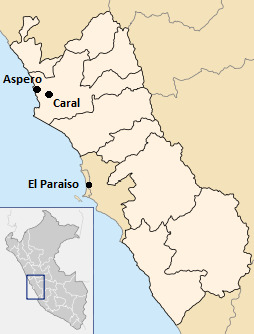
By Ontrvet - Own work, CC BY-SA 3.0, https://commons.wikimedia.org/w/index.php?curid=18736804
The Caral-Supe, also known as the Caral or Norte Chico, are a group of people that lived along the north-central coast of modern-day Peru from 3500-1800 BCE, contemporary to the building of the Egyptian pyramids. They also lived along the Fortaleza, Pativilca, and the Supe rivers. They are considered to be the oldest-known civilization in the Americas, predating cultures like the Olmecs by nearly 2000 years.

By I, KyleThayer, CC BY-SA 3.0, https://commons.wikimedia.org/w/index.php?curid=2441867
Though there was a complex culture, the Caral-Supe people did not leave any ceramics or evidence of other visual arts behind. They did grow cotton with irrigation, which was a very important crop for clothing and nets as their animal protein sources were marine, even among those who lived inland. This reliance on marine protein sources lead to the hypothesis called the "Maritime Foundations of Andean Civilizations' hypothesis (MFAC), in which the culture began on the coast and then moved inland to find and then cultivate cotton to support those on the coast.
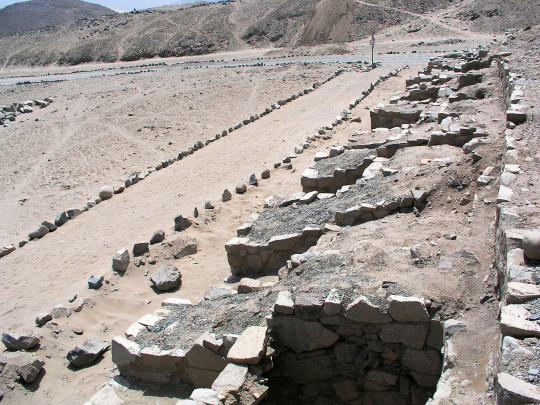
By I, Xauxa, CC BY 2.5, https://commons.wikimedia.org/w/index.php?curid=2503267
In addition to maritime protein, the Caral-Supe people also ate squash, beans, guava, and sweet potato, adding avocado and achira in northern areas. More recent studies also show that maize was also grown. Prior to about 2013, it was thought that the Caral-Supe didn't have a staple food that they grew. According to Evidence for maize (Zea mays) in the Late Archaic (3000–1800 B.C.) in the Norte Chico region of Peru published in 2013, 'New data drawn from coprolites, pollen records, and stone tool residues, combined with 126 radiocarbon dates, demonstrate that maize was widely grown, intensively processed, and constituted a primary component of the diet throughout the period from 3000 to 1800 BC.'
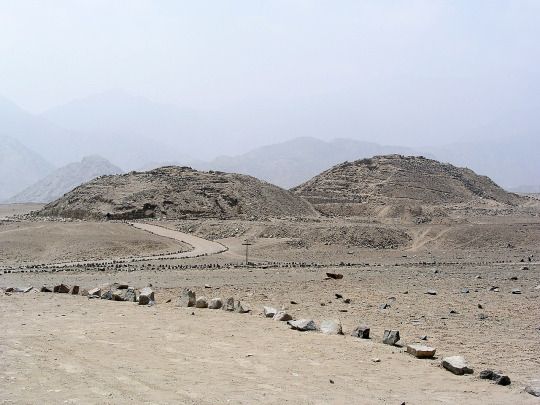
By I, Xauxa, CC BY 2.5, https://commons.wikimedia.org/w/index.php?curid=222037
Without an artistic or written record, it's difficult to know a lot about the Caral-Supe culture. They did leave behind a vast wealth of buildings, including large pyramids. They also built settlements close together, making it perhaps the most densely populated area area during the 3rd millennium BCE, with the possible exception of Northern China. Quipu have been found, though exactly how or why they were used is uncertain, as it is with later Andean civilizations.

Credit: Caral Archaeological Zone – Ministry of Culture of Peru
Efforts have been made to extrapolate what type of government the Caral-Supe people had, including the economy, ideology, and physical bases of power would have been. Evidence for a central government include some of the structures being built in one or two large pushes and large warehouses left behind. Other economic evidence include the trade relationships between the inland and maritime groups as well as those living else where as evidenced by 'Caral] exported its own products and those of Aspero to distant communities in exchange for exotic imports: Spondylus shells from the coast of Ecuador, rich dyes from the Andean highlands, hallucinogenic snuff from the Amazon.'

source: https://www.ancient-origins.net/ancient-places-americas/unique-artifacts-shed-light-daily-life-5000-year-old-city-caral-002019
The ideology is harder to pin down because they didn't decorate their buildings. A gourd was found with what appears to be the Staff God, a depiction of a human-like figure holding instruments of power, this one being 'a leering figure with a hood and fangs' and it is the oldest such depiction. As this type of depiction is common among other pre-Colombian Andean societies, it is thought that access to deities and the supernatural was a part of the purpose of government.

By I, Xauxa, CC BY 2.5, https://commons.wikimedia.org/w/index.php?curid=2488467
Physical evidence includes a lack of damage due to warfare, including a lack of bodies that were injured in warfare, nor are there walls around the settlements. The complexity of Caral-Supe culture without the evidence of warfare or need for defense driving kin groups into larger societies is unique among those ancient societies that have been studied. Most complex cultures came about as a way to defend against others.
Further Reading:
Pyramidal structure unearthed in Chupacigarro, Peru
20 notes
·
View notes
Text
🧪The sodium-potassium pump🧬
Greetings, Tumblr community! 🧠💡 Let's engage in a comprehensive exploration of the sodium-potassium pump, dissecting its molecular intricacies and elucidating its critical role in cellular homeostasis.
Introduction:
The sodium-potassium pump, residing within the cellular membrane, is an adenosine triphosphate (ATP)-dependent transmembrane protein pivotal for maintaining ionic balance. Its primary function is to actively transport three sodium ions out of the cell while concurrently importing two potassium ions.
Functional Mechanism:
In terms of mechanistic precision, the sodium-potassium pump operates as an ATPase enzyme, utilizing the energy derived from ATP hydrolysis. This primary active transport process involves sequential conformational changes within the pump's structure.
The process commences with the binding of intracellular sodium ions to high-affinity sites on the pump. Subsequent phosphorylation, facilitated by ATP, induces conformational alterations that render the pump receptive to extracellular potassium ions. This triggers dephosphorylation, allowing potassium ions to be released intracellularly.
This orchestrated ion exchange serves to uphold the electrochemical gradient across the cellular membrane, establishing and preserving the resting membrane potential. In essence, the sodium-potassium pump is the architect of the delicate balance between sodium and potassium concentrations.
Physiological Significance:
The physiological ramifications of this meticulous ion transport extend to neuronal excitability and osmoregulation. By contributing to the establishment of the resting membrane potential, the pump plays a pivotal role in regulating action potentials and facilitating the propagation of nerve impulses.
Additionally, the pump actively participates in cellular volume control through osmoregulation. Its influence on water movement prevents cellular swelling or shrinkage, underscoring its significance in maintaining cellular integrity.
For those seeking empirical validation, consider consulting the following authoritative sources:
1. **Alberts B, Johnson A, Lewis J, et al.** Molecular Biology of the Cell. 4th edition. New York: Garland Science; 2002. Section 11.3, The Plasma Membrane.
2. **Nelson DL, Cox MM.** Lehninger Principles of Biochemistry. 7th edition. New York: W.H. Freeman; 2017. Chapter 11, Active Transport and the Cytoskeleton.
3. **Lodish H, Berk A, Zipursky SL, et al.** Molecular Cell Biology. 4th edition. New York: W. H. Freeman; 2000. Section 15.1, The Transport of Small Molecules Across Membranes.
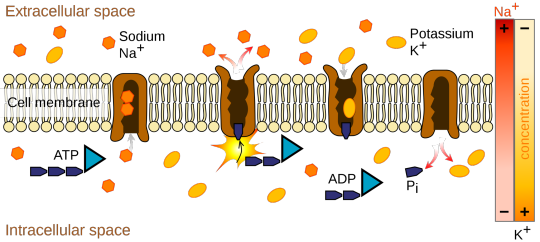
Immerse yourself in the scientific intricacies of cellular dynamics with these foundational resources! 📚✨
#science#biology#college#education#school#student#medicine#doctors#health#healthcare#nursing#nurses#nurselife#human physiology#physiology
152 notes
·
View notes
Note
Can you explain to me the chemistry behind the denaturation of enzymes and the process of allosteric and competitive inhibition?
First of all it's important to understand what an enzyme is. An enzyme is a protein, that catalyses reactions after binding to a substrate and then converts it or splits it. An enzyme has a very specific shape so it can bind to the substrate, it's like a key and a lock. The substrate binds to the binding site, and in the catalytic or active centre the reaction takes place.
This is important to understand denaturation: Proteins are made out of amino acids that are bound with peptide bonds. Proteins have several levels of structure: Their primary level is the sequence of amino acids, the secondary structures are folded structures due to interactions of the peptide backbones via hydrogen bonds, like alpha helices or beta sheets. The tertiary structure is folding of the peptides due to electrochemical interactions between different amino acids. Amino acids can have different charges due to their side chains, they can be positive, negative or neutral charged. So those charges will either attract or repel each other, putting the peptide chain in a certain three dimensional shape or conformation. In the quaternary structure several peptide chains come together to create a bigger functional unit (the enzyme) made out of subunits, they often also interact with ions (cofactors) as their catalytic centre where the catalysed reaction takes place. All those levels create the specific shape of the enzyme that is required to bind to their target substrate. So if those structures are changed in any way, it won't work anymore because it can't bind. Just reading it probably makes it difficult to understand, so here's a textbook graphic.
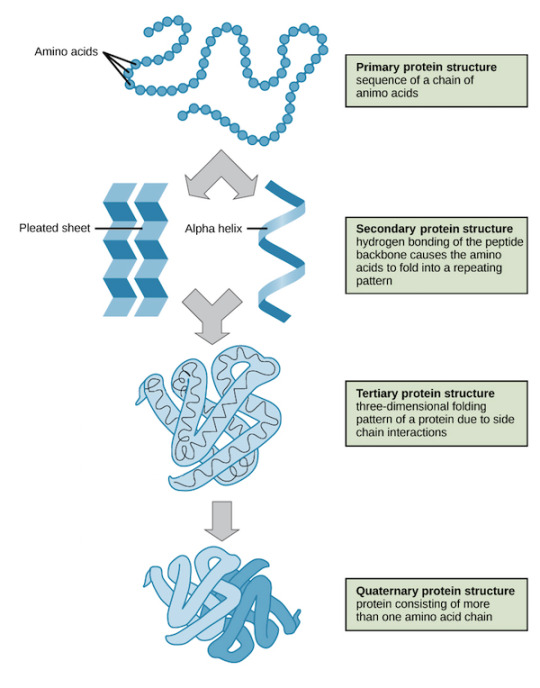
This shape can be changed by denaturation. A protein can be denaturated by heat, or changed pH or high salinity and other not optimal conditions. During those conditions like changed pH the interactions between the molecules and side chains do not work anymore because pH can change the charges of the sidechains, so secondary, tertiary and quarternary structures will be changed. When those structures are changed the binding site will change too and not resemble the lock anymore where the key substrate can bind, so now the enzyme is inactivated/inhibited.
Enzymes can also be inhibited (or activated) by regulatory molecules binding to the enzyme, inhibitors or activators. This can be a competitive inhibition, when the inhibitor binds at the same binding and active site and blocking it, making the actual substrate that should be processed unable to bind there. Like a lock that already has a key stuck in it, you can't put another key in there. Allosteric inhibition is when the inhibitor binds at another site, not directly at the active site where the substrate binds. But by binding to the allosteric site the conformation of the enzyme gets changed by chemical interactions, changing the binding site so the substrate doesn't get recognised anymore. A key can't be insterted into a lock that has been changed.
Inhibtion can be irreversible (making the enzyme dysfuntional for the rest of it's existence until it is degraded) or reversible.
#roleplay#rp#sherlock roleplay#sherlock rp#sherlock#sherlock holmes#biology#molecular biology#biochemistry#chemistry#a level chemistry#chemblr#bioblr#science#scientist#scienceblr#biology student#biology facts#a level biology#enzyme inhibitors#protein#molecular biology enzymes#science side of tumblr#studying#biology studyblr#chemistry major#biology major#college#university#sherlock replies
39 notes
·
View notes
Text
to dos // updated 14th Feb, 2024
primary tasks
✅ compile fasta seq into a single file ✅ look up structural superimposition tools for protein annotation
48 notes
·
View notes
Text

Close-up on Cilia
Almost every cell in your body has a little antenna sending and receiving chemical and mechanical signals. These thread-like projections are called primary cilia. To better understand the importance of these structures, researchers have tried to identify proteins located on them. However, this has proven challenging as primary cilia overlap with other cell structures such as the cell membrane. Now researchers have developed an effective way to definitively localise primary cilia’s proteins in 3D by combining surface scanning electron microscopy with antibody-based labelling (immuno-SEM). Here, a protein called IFT88 (white dots) – which if mutated can cause serious disorder – is revealed on a cilium on a mouse pancreatic cell. This powerful, high-resolution tool will aid research into primary cilia and ciliopathies – a range of serious diseases caused by cilia dysfunction.
Written by Lux Fatimathas
Image from work by Sanja Sviben and colleagues
Department of Cell Biology and Physiology, Washington University School of Medicine, Saint Louis, MO, USA
Image originally published with a Creative Commons Attribution 4.0 International (CC BY 4.0)
Published in Journal of Cell Science, May 2024
You can also follow BPoD on Instagram, Twitter and Facebook
16 notes
·
View notes
Text
Reference saved in our archive
This is why we can't just vax and relax: Covid naturally evolves to evade our immune responses, even those attenuated by vaccines. It cannot evolve to evade physical barriers like masks, air filtration, and proper ventilation.
Abstract SARS-CoV-2 JN.1 with an additional L455S mutation on spike when compared with its parental variant BA.2.86 has outcompeted all earlier variants to become the dominant circulating variant. Recent studies investigated the immune resistance of SARS-CoV-2 JN.1 but additional factors are speculated to contribute to its global dominance, which remain elusive until today. Here, we find that SARS-CoV-2 JN.1 has a higher infectivity than BA.2.86 in differentiated primary human nasal epithelial cells (hNECs). Mechanistically, we demonstrate that the gained infectivity of SARS-CoV-2 JN.1 over BA.2.86 associates with increased entry efficiency conferred by L455S and better spike cleavage in hNECs. Structurally, S455 altered the mode of binding of JN.1 spike protein to ACE2 when compared to BA.2.86 spike at ACE2H34, and modified the internal structure of JN.1 spike protein by increasing the number of hydrogen bonds with neighboring residues. These findings indicate that a single mutation (L455S) enhances virus entry in hNECs and increases immune evasiveness, which contribute to the robust transmissibility of SARS-CoV-2 JN.1. We further evaluate the in vitro and in vivo virological characteristics between SARS-CoV-2 BA.2.86/JN.1 and EG.5.1/HK.3, and identify key lineage-specific features of the two Omicron sublineages that contribute to our understanding on Omicron antigenicity, transmissibility, and pathogenicity.
#mask up#covid#public health#pandemic#wear a mask#wear a respirator#covid 19#still coviding#coronavirus#sars cov 2#covid pandemic#covid conscious#covid is airborne#covid isn't over#covid19#covidー19
31 notes
·
View notes
Text
EMPLOYEE DATA BASE (CURLY HISTORY)

2062, Age 0:
Curly, Grant born. Family: Mother, father, and elder brothers Garrett (age 4) and James (age 10). Socioeconomic Status: Middle class.
2069, Age 7
Event: Centennial of the Moon Landing celebrated on Earth. Family relocates to Mars. Noted Development: Initial documented interest in space.
2071-2072, Age 9-10
Family Event: Birth of sister Grayce Curly on Mars. Movement: Return to Earth with family. Notable Interaction: Captain allows Grant access to cockpit; basic piloting skills introduced during year-long transit.
2074, Age 12
Family Event: Brother James Curly weds Mark Thilman. Social Development: First meeting with James “Jimmy” Zimmer (age range: peer); close friendship formation noted.
2078, Age 16
Academic Milestone: Completion of secondary education. Relocation: Moves to United States; proximity to NASA cited as primary motive. Social Note: Jimmy Zimmer relocates concurrently.
2080, Age 20
Academic Milestone: Earns Associate of Science (AS) degree.
2081, Age 21
Social Note: 21st birthday celebrated by Jimmy Zimmer and friends with improvised, structurally unsound cake (composition: chocolate, caramel, protein powder). Positive reception despite substandard culinary result.
2082, Age 22
Academic Milestone: Earns Bachelor of Science (BS) degree.
2084, Age 24
Academic Milestone: Master’s degree (field: STEM) completed. Application: NASA Astronaut Corps. Denied due to sub-threshold In-Command piloting hours (Requirement: 1000 hours).
2085-2086, Age 25-26
Career Development: Joins Pony Express as co-pilot on freight vessel Grypus, motivated by piloting hours acquisition. Begins identifying professionally as “Curly.”
2086-2087, Age 26-27
Mission Record: Second freight mission aboard Grypus; routine. Polle terrifies him.
2087-2089, Age 27-29
Mission Record: Extended freight mission; crew experienced significant musculoskeletal degradation, with Curly maintaining health due to rigorous exercise regimen. Avoidance of legal liability for Pony Express attributed to Curly’s preventative measures—this causes Pony Express to favor him.
2091-2092, Age 30-31
Career Development: Reassigned as co-pilot to freight vessel Tulpar. Met mechanic Swansea; friendship recorded.
2092-2093, Age 31-32
Mission Record: Final assignment with Pony Express prior to intended NASA reapplication.
2094, Age 33
Employment Offer: Captaincy of Pony Express offered; declined initially. Reconsidered following conversation with Jimmy Zimmer regarding career aspirations, and possible career failures. Position accepted.
2095, Age 34
Mission Record: First command as Captain; short-range freight mission completed.
2096, Age 35
Crew Incident: Co-pilot of Tulpar reported deceased (suicide). Curly successfully persuaded Jimmy Zimmer to join as new co-pilot.
2097-2098, Age 36-38
Financial Note: Reduction in wages for all personnel. Crew Addition: New member Anya joins.
2098, Age 38
Mission Record: Minor freight mission. Informal reports suggest mechanic Swansea’s intent to retire.
2099–, Age 39
Crew Addition: Daisuke joins crew of Tulpar as intern, anticipated to replace Swansea if retirement proceeds. Crew departs.
8 notes
·
View notes
Text
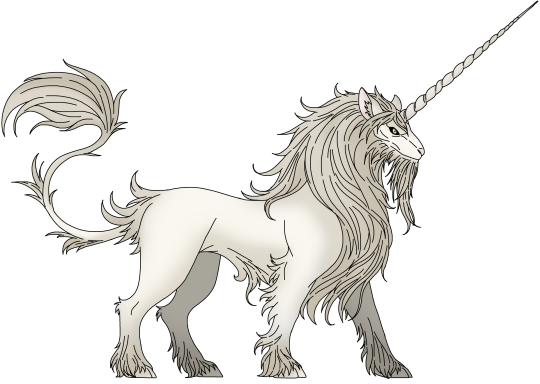
Common Name: Unicorn Scientific Name: Ferox unicornis
Physical Description
Average Size: 90 cm (35.4 inches) tall at the shoulder, similar to a large goat or small pony.
Appearance: A muscular, compact body covered in a dense, silvery-white coat. The mane and tail are long, flowing, and often appear slightly darker, with a coarse texture. The unicorn has a single, spiraled horn protruding from its forehead, which is both a symbol of power and a formidable weapon. Its eyes are deep and intense, reflecting a wild and intelligent nature. The legs are sturdy, with strong cloven hooves that can deliver powerful kicks. Despite its small size, it exudes an aura of strength and wildness. The stance often resembles that of a fierce predator, with a slight crouch and poised readiness.
Diet
Type: Herbivore with occasional omnivorous tendencies.
Primary Foods:
Grasses, leaves, and tender shoots.
Berries, fruits, and nuts from the forest.
Occasionally, small animals or eggs during times of scarcity.
Special Adaptations: The unicorn's digestive system is highly adaptable, allowing it to thrive on various plant matter and occasional protein sources.
Habitat
Environment: Dense forests, mountainous regions, and grassy meadows. Prefers secluded areas away from human settlements.
Shelter: Caves, dense thickets, or naturally formed shelters in rocky outcrops. Often found near freshwater sources.
Behavior and Living Habits
Activity Cycle: Primarily diurnal, but can be active during twilight hours (crepuscular) to avoid the heat of the day or human encounters.
Social Structure: Solitary by nature, wild unicorns fiercely defend their territory. However, during certain times of the year, small groups may form around abundant resources or during mating season.
Territoriality: Unicorns mark their territory using scent glands located near their hooves and with prominent scratch marks from their horn on trees and rocks.
Reproduction
Mating Season: Late winter to early spring, coinciding with the regeneration of plant life.
Reproductive Strategy: Females give birth to a single foal after a gestation period of 8 months. Foals are precocial, able to stand and move within hours of birth, but they remain with their mothers for up to a year for protection and guidance.
Nest: The mother often chooses secluded, well-hidden locations for birthing, such as dense underbrush or shallow caves.
Behavior and Temperament
Defensive Behavior: When threatened, the unicorn may lower its head to charge with its horn or rear up to deliver powerful kicks. Its fierce temperament makes it a formidable opponent in the wild.
Foraging Habits: Moves silently through its territory, using keen senses of hearing and smell to detect food or threats. It is known to use its horn to dig for roots or knock down fruits from trees.
Interaction with Humanoids: Wild unicorns are highly dangerous and avoid humanoid contact. However, domesticated unicorns form deep bonds with their owners, showing loyalty and affection, but taming one requires patience and respect. Virgin individuals, or anyone with a deep purity, regardless of gender, seem to have an easier time earning the unicorn's trust, possibly due to their perceived innocence. Non-virgins and average person can also approach but may require more time and effort to gain trust. Faes also have more facility to approach them.
Size:
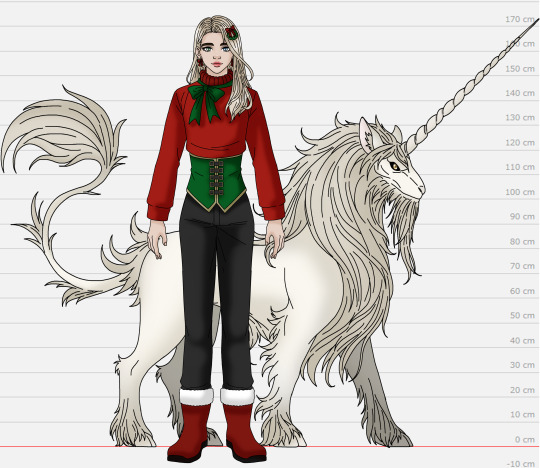
Based on the clearly non-horse medieval original unicorn


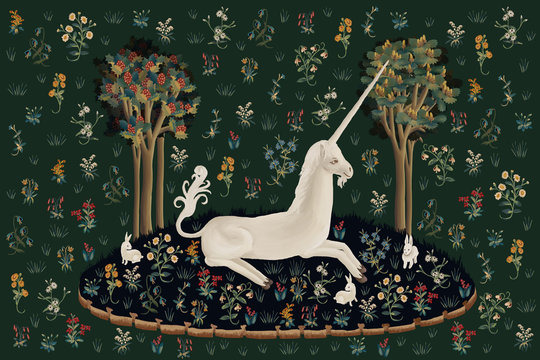



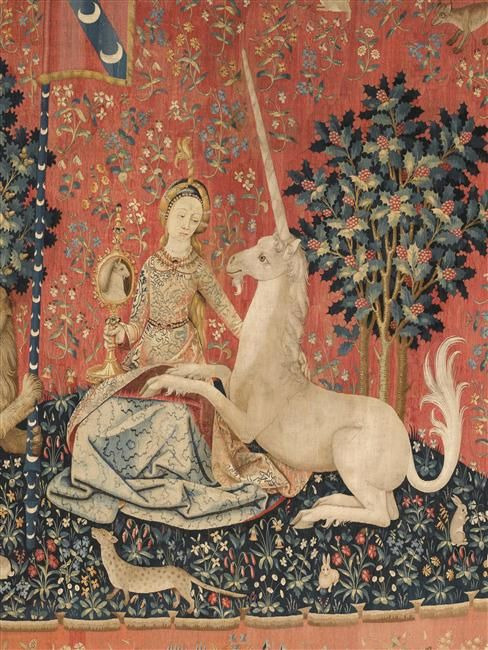



#art#original story#original character#fairytale#disney twst#unicorn#Legends of the Written Realms#fablewood academy#LoWR#creature#bestiary#medieval
11 notes
·
View notes
Text
A Comprehensive Diet Plan for Managing Hypoglycemia
Introduction
Hypoglycemia, often referred to as low blood sugar, is a condition characterized by abnormally low levels of glucose in the blood. Glucose is the primary source of energy for the body’s cells, and maintaining its levels within a healthy range is crucial for optimal functioning. Hypoglycemia can cause symptoms like shakiness, dizziness, confusion, and in severe cases, unconsciousness. A well-structured diet plan is essential for managing hypoglycemia, as it helps stabilize blood sugar levels and prevent episodes of low blood sugar.
Understanding Hypoglycemia
Before diving into the diet plan, it’s important to understand the types and causes of hypoglycemia. Hypoglycemia can be classified into two categories:
Reactive Hypoglycemia: This occurs within a few hours after eating, often due to an excessive insulin response that drives blood sugar levels too low.
Fasting Hypoglycemia: This type occurs when blood sugar drops after fasting or going without food for an extended period.
Common causes of hypoglycemia include diabetes management (particularly insulin or medication use), prolonged fasting, excessive alcohol consumption, and certain medical conditions. Regardless of the cause, a balanced diet plays a critical role in managing the condition.
Key Principles of a Hypoglycemia Diet Plan
The goal of a diet plan for hypoglycemia is to maintain steady blood glucose levels throughout the day. Here are the key principles:
Frequent Small Meals: Eating smaller, more frequent meals (every 3-4 hours) helps prevent large fluctuations in blood sugar levels. This approach keeps glucose levels stable and provides a constant source of energy.
Balanced Macronutrients: Each meal should include a combination of complex carbohydrates, protein, and healthy fats. This balance helps slow the absorption of glucose into the bloodstream and provides a steady release of energy.
Focus on Complex Carbohydrates: Complex carbohydrates, such as whole grains, vegetables, and legumes, are digested more slowly than simple sugars, preventing rapid spikes and drops in blood sugar levels.
Include Protein in Every Meal: Protein helps slow down carbohydrate absorption and keeps you feeling full longer. Good sources include lean meats, fish, eggs, dairy products, legumes, and nuts.
Healthy Fats: Incorporating healthy fats like those found in avocados, nuts, seeds, and olive oil can help stabilize blood sugar and provide long-lasting energy.
Avoid Simple Sugars and Refined Carbs: Foods high in refined sugars and simple carbohydrates, such as candy, sugary drinks, and white bread, can cause rapid spikes followed by sharp drops in blood sugar levels.
Stay Hydrated: Proper hydration is essential, as dehydration can worsen the symptoms of hypoglycemia. Water, herbal teas, and electrolyte-balanced drinks are good choices.
Sample Diet Plan for Hypoglycemia
Here’s a sample one-day meal plan designed to help manage hypoglycemia:
Breakfast:
- Oatmeal: Made with rolled oats, topped with sliced almonds, chia seeds, and a handful of fresh berries.
- Greek Yogurt: A small serving of unsweetened Greek yogurt for added protein.
Mid-Morning Snack:
- Apple Slices with Nut Butter: An apple sliced and spread with almond or peanut butter.
- Hard-Boiled Egg: For extra protein.
Lunch:
- Grilled Chicken Salad: Mixed greens with grilled chicken, quinoa, cherry tomatoes, cucumbers, and a dressing made from olive oil and lemon juice.
- Whole-Grain Crackers: A small serving for added complex carbohydrates.
Afternoon Snack:
- Hummus with Veggies: Carrot sticks, celery, and bell pepper slices dipped in hummus.
- Mixed Nuts: A small handful of unsalted mixed nuts.
Dinner:
- Baked Salmon: A portion of baked salmon served with steamed broccoli and sweet potatoes.
- Brown Rice: A small serving for added complex carbohydrates.
Evening Snack:
- Cottage Cheese: A small serving of cottage cheese topped with a few slices of avocado.
- Berries: A handful of mixed berries.
Additional Tips
Monitor Portion Sizes: Eating too much at one time can cause blood sugar levels to spike and then crash. Pay attention to portion sizes and avoid overeating.
Limit Alcohol: If you consume alcohol, do so in moderation and never on an empty stomach, as it can lower blood sugar levels.
Keep Emergency Snacks Handy: In case of a hypoglycemic episode, keep snacks like glucose tablets, juice boxes, or a small pack of crackers nearby.
Consult with a Healthcare Professional: It’s important to work with a healthcare provider or a registered dietitian to create a personalized plan that suits your individual needs and medical condition.

Simple Technique To Help Manage Blood Sugar
Conclusion
Managing hypoglycemia through diet requires careful planning and consistency. By eating balanced meals regularly, focusing on nutrient-dense foods, and avoiding simple sugars, individuals with hypoglycemia can better control their blood sugar levels and reduce the risk of low blood sugar episodes. Remember, each person’s nutritional needs are different, so it’s essential to tailor the diet plan to your specific condition and lifestyle.
#health tips#healthcare#diabetes supplement#diabetic support supplement#blood sugar supplement#diabetes#hypoglycemia
12 notes
·
View notes